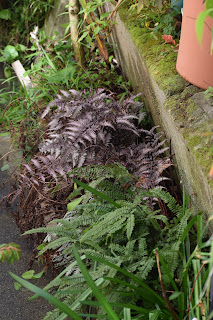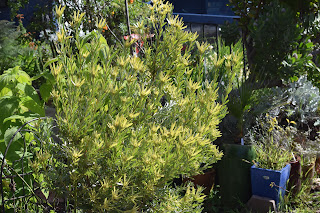We're in that late March and April flux, when one day is spring and the following is winter. Amazingly, our gardens seem to manage these changes, continuing to move forward. My all season garden is ploughing ahead (pun intended), with new things nearly every few days when I take a walk through and make notes in my journal. This is the time of year for the early bulbs, the mid-season camellias, the early wildflowers and the return of deciduous shrubs and trees. Deciduous ferns too are springing back to life and the first of the deciduous begonias are sprouting new leaves. In that light, here is a sampling of 'one day in my garden'.
I name all my beds - usually with practical, descriptive names - and this is the one I call the Walkway Bed. These names help me find plants from the list I keep on my computer. And trust me, with 250+ different plants in my garden, that list comes in handy! My Walkway Bed is filled this time of year with a variety of spring bulbs, 2 Monardellas, 2 Eriogonums, an Erysimum and more!
Here are a couple of my many variety of daffodils.
One of the real success stories these last few years has been my Salvia aurea. It's rooted down through its gallon pot and is blooming like the dickens!
Another success story is my Melaleuca incana. Here it is in full bloom. The bees adore the flowers, so that is a big bonus in growing it in my front yard.
More of the double form of daffodil. Daffodils are one of the easiest and most reliable flowers to grow.
Viburnums are one of those shrubs that should be on more people's radar. This V. x burkwoodii's flowers are super fragrant, somehow both sweet & woodsy scented.
This fabulous perennial is one many gardeners have never heard of - Gnidia polystacha. It blooms prolifically, with sweet little yellow flowers. It hails from South Africa, which has a climate very similar to ours.
Another seldom scene flower is this Ipomopsis 'Skyrocket'. Delicate green foliage then lots of rosy flared trumpet flowers in late spring.
So many daffodils, so little time ...
Here's a plant many are familiar with (Bottlerbrush tree) but a particular species (Callistemon pachyphyllus) that features unusual green flowers.
Tulip 'Orang Brilliant'. Mine came out a bit redder than orange but still lovely.
This white-flowering form of Tulipa clusiana is a real eye-catcher!
Abutilon 'Tiger Eye'. One of the most popular flowering maples sold in the trade and here's why.
I had to shoot this Gladiolus Nanus Mix flower through a stem so the focus isn't perfect. It's one of the many noteworthy species Glads out there.
My Aloe striata (Coral aloe) blooms faithfully every late winter, giving the hummingbirds a valuable source of nectar this time of year.
This crazy looking flower is a Ferraria crispa (dark form). Sometimes known as a Spider iris, it has pronounced crinkled edges and an intricate nectary.
Perhaps the most common of all the species tulips, Tulipa saxatilis is nonetheless very showy.
I took this photo of a newly added Aeonium as much for its unusual pot as for the plant itself. If you look carefully, you can see a series of faces ringing the pot.
My Japanese painted ferns have already begun to leaf. They look delicate but are actually one of the most durable ferns you can add to your garden.
My Agapetes serpens has finally overcome a bad case of thrips and has produced its first flowers in four years. Yea!
It's been a good winter for my Hellebores. This unusual one, sold by Annie's Annuals, is called 'Peppermint Ice'. Hard to see here but it has speckled petals.
Every garden needs at least one Cyclamen plant.
Finally, here is my exuberant Pelargonium 'Caroline's Citrine'. Lovely and it thrives in shade.















































